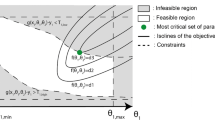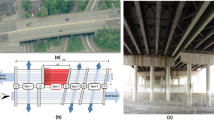Abstract
Transportation networks provide an essential contribution to addressing the needs of reliable and safe mobility in urban environments. The core of these networks is made up of infrastructure such as roads and bridges that often, have not been designed to meet current needs. Optimal management requires an accurate knowledge of how existing structures behave. This helps avoid unnecessary replacement and expensive interventions when cheaper and more sustainable alternatives are available. Structural-model updating takes advantage of measurements and more qualitative observations to identify suitable behaviour model classes and values for parameters that influence real behaviour. Error domain model falsification (EDMF) has been proposed as a robust population-based methodology to identify sets of models by comparing finite-element model predictions with measurements at sensor locations. This paper introduces a methodology, which is compatible with EDMF, to assess the reserve capacity of bridges for serviceability and ultimate limit states. A case study—the structural identification of a reinforced-concrete bridge in Singapore—illustrates the framework developed for the estimation of reserve capacity. Several analyses with increasing levels of model detail using design and updated values of relevant parameters are presented. Traffic-load specifications of design-stage codes (British Code—1978) and current codes (Eurocodes) are compared. Results show that typical conservative practices carried out during design and construction have led to an as-built reserve capacity of 60%. A large proportion of the as-built reserve capacity has been exploited to accommodate dramatically increased values of traffic-load specifications that are provided by current Singapore codes which have caused a reduction in reserve capacity to 20%. Such a reduction may be less significant in countries where code specifications have not changed as much. Finally, it is shown that advanced methods of analysis and assessment are more suitable than design-stage approaches to quantify the reserve capacity.















Similar content being viewed by others
References
World Economic Forum (2014) Strategic infrastructure, steps to operate and maintain infrastructure efficiently and effectively. Tech. Rep. 180314, World Economic Forum, Davos
FHWA (Federal Highway Administration) (2015) 2015 status of the Nation’s highways, bridges, and transit: conditions & performance. In: Rep. to congress
Frangopol DM (2011) Life-cycle performance, management, and optimisation of structural systems under uncertainty: accomplishments and challenges 1. Struct Infrastruct Eng 7(6):389–413
Lounis Z, McAllister TP (2016) Risk-based decision making for sustainable and resilient infrastructure systems. J Struct Eng 142(9), F4016,005
Neves AC, González I, Leander J, Karoumi R (2017) Structural health monitoring of bridges: a model-free ann-based approach to damage detection. J Civ Struct Health Monit 7(5):689–702
Catbas FN, Aktan AE (2002) Condition and damage assessment: issues and some promising indices. J Struct Eng 128(8):1026–1036
Brownjohn JMW, De Stefano A, Xu YL, Wenzel H, Aktan AE (2011) Vibration-based monitoring of civil infrastructure: challenges and successes. J Civ Struct Health Monit 1(3):79–95
Smith IFC (2016) Studies of Sensor Data interpretation for Asset Management of the Built environment. Front Built Environ 2:8
fib International Federation for Structural Concrete (2010) Model Code for concrete structures 2010
Vrouwenvelder T (1997) The JCSS probabilistic model code. Struct Saf 19(3):245–251
Brhwiler E, Vogel T, Lchinger P, Lang T (2012) Swiss standards for existing structures. Struct Eng Int 22(2):275–280
Winiewski DF, Casas JR, Ghosn M (2012) Codes for safety assessment of existing bridgescurrent state and further development. Struct Eng Int 22(4):552–561
Holický M, Návarová V, Gottfried R, Kronika M (2014) Basics for assessment of existing structures. Base of reliability theory and risk evaluation. KI CTU Prague
Ghosn M, Frangopol DM, McAllister TP, Shah M, Diniz SMC, Ellingwood BR, Manuel L, Biondini F, Catbas N, Strauss A et al (2016) Reliability-based performance indicators for structural members. J Struct Eng 142(9), F4016,002
Minervino C, Sivakumar B, Moses F, Mertz D, Edberg W (2004) New AASHTO guide manual for load and resistance factor rating of highway bridges. J Bridge Eng 9(1):43–54
Çatbaş FN, Kijewski-Correa T, Aktan AE (eds) (2013) Structural identification of constructed systems: approaches, methods, and technologies for effective practice of St-Id. American Society of Civil Engineers
Beck JL, Katafygiotis LS (1998) Updating models and their uncertainties. I: Bayesian statistical framework. J Eng Mech 124(4):455–461
Goller B, Beck JL, Schueller GI (2011) Evidence-based identification of weighting factors in Bayesian model updating using modal data. J Eng Mech 138(5):430–440
Lam HF, Yang J, Au SK (2015) Bayesian model updating of a coupled-slab system using field test data utilizing an enhanced Markov chain Monte Carlo simulation algorithm. Eng Struct 102:144–155
Simoen E, Papadimitriou C, Lombaert G (2013) On prediction error correlation in Bayesian model updating. J Sound Vib 332(18):4136–4152
Pasquier R, Smith IFC (2015) Sources and forms of modelling uncertainties for structural identification. In: 7th International conference on structural health monitoring of intelligent infrastructure (SHMII)
Goulet JA, Smith IFC (2013) Structural identification with systematic errors and unknown uncertainty dependencies. Comput Struct 128:251–258
Pasquier R, Smith IFC (2015) Robust system identification and model predictions in the presence of systematic uncertainty. Adv Eng Inform 29(4):1096–1109
Muttoni A, Ruiz MF (2012) Levels-of-approximation approach in codes of practice. Struct Eng Int 22(2):190–194
Plos M, Shu J, Zandi K, Lundgren K (2017) A multi-level structural assessment strategy for reinforced concrete bridge deck slabs. Struct Infrastruct Eng 13(2):223–241
Tapan M, Aboutaha RS (2008) Strength evaluation of deteriorated RC bridge columns. J Bridge Eng 13(3):226–236
Frangopol D, Tsompanakis Y (2014) Maintenance and safety of aging infrastructure: structures and infrastructures book series, vol 10. CRC Press, Boca Raton
Miller RA, Aktan AE, Shahrooz BM (1994) Destructive testing of decommissioned concrete slab bridge. J Struct Eng 120(7):2176–2198
Richard B, Epaillard S, Cremona C, Elfgren L, Adelaide L (2010) Nonlinear finite element analysis of a 50 years old reinforced concrete trough bridge. Eng Struct 32(12):3899–3910
Pimentel M, Brhwiler E, Figueiras J (2014) Safety examination of existing concrete structures using the global resistance safety factor concept. Eng Struct 70:130–143
Zheng Y, Robinson D, Taylor S, Cleland D (2009) Finite element investigation of the structural behaviour of deck slabs in composite bridges. Eng Struct 31(8):1762–1776
Pimentel M, Brwhiler E, Figueiras J (2010) Extended cracked membrane model for the analysis of RC panels. Eng Struct 32(8):1964–1975
Cervenka V (2002) Computer simulation of failure of concrete structures for practice. In: 1st fib congress, 13 Oct 2002, pp 289–304
Schlune H, Plos M, Gylltoft K (2009) Improved bridge evaluation through finite element model updating using static and dynamic measurements. Eng Struct 31(7):1477–1485
Pasquier R, Smith IFC (2016) Iterative structural identification framework for evaluation of existing structures. Eng Struct 106:179–194
Goulet JA, Kripakaran P, Smith IFC (2010) Multimodel structural performance monitoring. J Struct Eng 136(10):1309–1318
Pasquier R, DAngelo L, Goulet JA, Acevedo C, Nussbaumer A, Smith IFC (2016) Measurement, data interpretation, and uncertainty propagation for fatigue assessments of structures. J Bridge Eng 21(5), 04015,087
Pasquier, R., Goulet, J.A., Acevedo, C., Smith, I.F.C.: Improving fatigue evaluations of structures using in-service behavior measurement data. Journal of Bridge Engineering 19(11), 04014,045 (2014)
Schlune H, Plos M, Gylltoft K (2012) Safety formats for non-linear analysis of concrete structures. Mag Concrete Res 64(7):563–574
Cervenka V, Cervenka J, Pukl R (2007) Safety assessment in fracture analysis of concrete structures. In: Proceedings of the 6th international conference on fracture mechanics of concrete and concrete stuctures, vol 2. Catania, pp 1043–1049
Cervenka V, Cervenka J, Pukl, R (2007) Safety assessment in fracture analysis of concrete structures. In: Proceedings of the 6th international conference on fracture mechanics of concrete and concrete stuctures, Catania, vol. 2, pp. 1043–1049
(2002) En 1990 eurocode 0—basis of structural design
Vernay D, Favre FX, Smith IFC (2018) Robust model-updating methodology for estimating worst-case loading capacity of existing bridges. J Civ Struct Health Monit (under review)
(2011) Sia-269:2011 existing structures - Bases
(1978) Bs-5400-2:1978 steel, concrete and composite bridges. Specification for loads
(1984) Bs-5400-4:1984 steel, concrete and composite bridges. Code of practice for design of concrete bridges
(2012) Ss-en-1991-2 eurocode 1 actions on structures - Part 2: Traffic loads on bridges
(2012) Ss-en-1992-2 eurocode 2 design of concrete structures—Concrete bridges: Design and detailing rules
Helland S (2013) Design for service life: implementation of fib Model Code 2010 rules in the operational code ISO 16204. Struct Concrete 14(1):10–18
Proverbio M, Costa A, Smith IFC (2018) Adaptive sampling methodology for structural identification using radial-basis functions. J Comput Civ Eng 32(3):04018008
Muttoni A, Fernndez Ruiz M, Niketic F, Backes MR (2016) Assessment of existing structures based on elastic-plastic stress fields-Modelling of critical details and investigation of the in-plane shear transverse bending interaction. Tech. rep., Rapport OFROU, N. 680, Switzerland
Ruiz MF, Muttoni A (2007) On development of suitable stress fields for structural concrete. ACI Struct J 104(4):495
Blomfors M, Engen M, Plos M (2016) Evaluation of safety formats for non-linear finite element analyses of statically indeterminate concrete structures subjected to different load paths. Struct Concrete 17(1):44–51
Cervenka V (2013) Reliability-based non-linear analysis according to fib Model Code 2010. Struct Concrete 14(1):19–28
Acknowledgements
The research was conducted at the Future Cities Laboratory at the Singapore-ETH Centre, which was established collaboratively between ETH Zurich and Singapore’s National Research Foundation (FI 370074016) under its Campus for Research Excellence and Technological Enterprise programme. The authors gratefully acknowledge the support of the Land Transport Authority (LTA) of Singapore for support during load tests in the scope of the case study.
Author information
Authors and Affiliations
Corresponding author
Ethics declarations
Conflict of interest
The authors declare that they have no conflict of interest.
Additional information
Publisher's Note
Springer Nature remains neutral with regard to jurisdictional claims in published maps and institutional affiliations
Rights and permissions
About this article
Cite this article
Proverbio, M., Vernay, D.G. & Smith, I.F.C. Population-based structural identification for reserve-capacity assessment of existing bridges. J Civil Struct Health Monit 8, 363–382 (2018). https://doi.org/10.1007/s13349-018-0283-6
Received:
Accepted:
Published:
Issue Date:
DOI: https://doi.org/10.1007/s13349-018-0283-6




